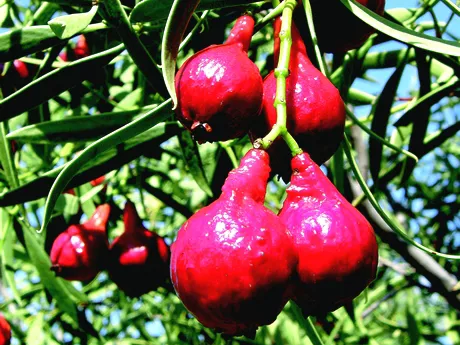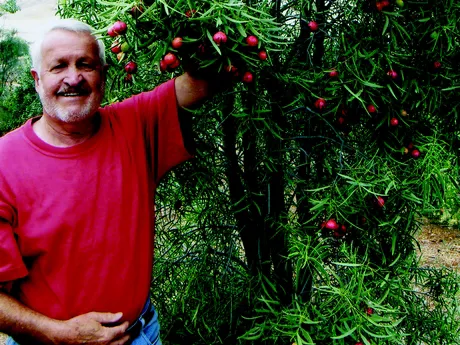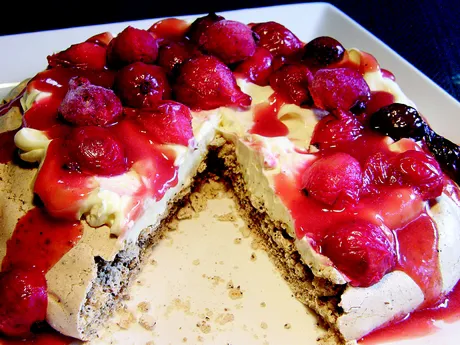Quandongs are one of the fastest growing additions to the Australian native fruit industry, according to grower and ethnobotanist Neville Bonney, who says it has grown in popularity over the past decade.
Traditionally eaten by Indigenous Australians for thousands of years, Neville says the fruit has similarities to a peach in flavour, and it was first cultivated and harvested around 50 years ago, and now there are some quite significant plantations of it.
"In the past 10 years it has become quite popular in restaurants," he said. "It can be used in many cooking recipes. It can be used as a sweet or in sour cooking. It can be used in desserts such as ice creams. It can be used in a nut slice, an after-dinner treat, or for dessert muffins, as well as quandong and apple pie. Even mustard, and liquors, which can be made from quandong fruits."

Neville Bonney says quandongs prefer hot and dry climates and will grow in most parts of Australia except for Tasmania and the tropics. It is sold at markets across the country, particularly in country or regional areas, and at smaller farmers' markets, although it is hard to measure exact production volumes.
"I think more so these days it is sold as value added products," Neville said. "There is even a shop, called 'The Quandong Cafe' in northern South Australia and they specialise in quandong pies and tourists come to visit. It is retailed in three ways; on the stone (fresh), and off the stone both dried, and frozen."
Quandongs have a fairly small ripening season, which runs from August until September-October - but can be stretched out slightly by up to 3-4 weeks depending on rainfall and where the crop is located.
"You need to know when to pick it, because if you go too early, the fruit is a little on the sour side," Neville said. "If you want to promote the product, you want it to be nice and ripe. When you press the fruit there is a stone inside, and if you feel that bit of movement between the stone and the fruit, you know that you are pretty right - and the fruit should have a deep red colour.”

Neville Bonney is one of around 25 growers who has a crop of around 50 trees in his orchard, while there are about the same amount who grow on a much smaller scale in their backyard, or as a hobby. There are even some very large commercial plantations that contain up to 1,000 trees.
He adds that while most of the fruit now is picked from cultivated plantations, there are still some quandongs that are picked from the wild - although you need to seek permission from the property owners before harvesting significant amounts.
"I would put it in the top three of the Australian bush foods," he said. "I think macadamia nuts would come first, then the use of lemon myrtle as a condiment would be second, but I think the 'Australian Native Peach' (quandong) would come in the first three of four. That's from my observations."
While it is known today as the quandong, Neville Bonney points out that each Aboriginal nation had different name, depending on what part of Australia they were living.
"You have to remember that the quandong was a genuine 'bush food' or wild food," Neville said. "The first people never used some of the bush food that we use today, because they never had the cooking facilities. Since the arrival of the Europeans, especially in the last 50-100 years, scientists are able to find new flavours and great food types out in the bush. The indigenous people never used it because they never had the modern methods, or cooking facilities to use them. You have to remember that indigenous Australians, before white-settlement, were acclimatised and had different taste buds to that of the European settlers.”

Health-wise, Neville Bonney says it is high in Vitamin C, while the kernels (nuts) were also used by indigenous people for medicinal purpose such as ointments - as well as body ornaments.
For more information
Neville Bonney
Phone: +61 419 803 189
nbonney@senet.com.au
